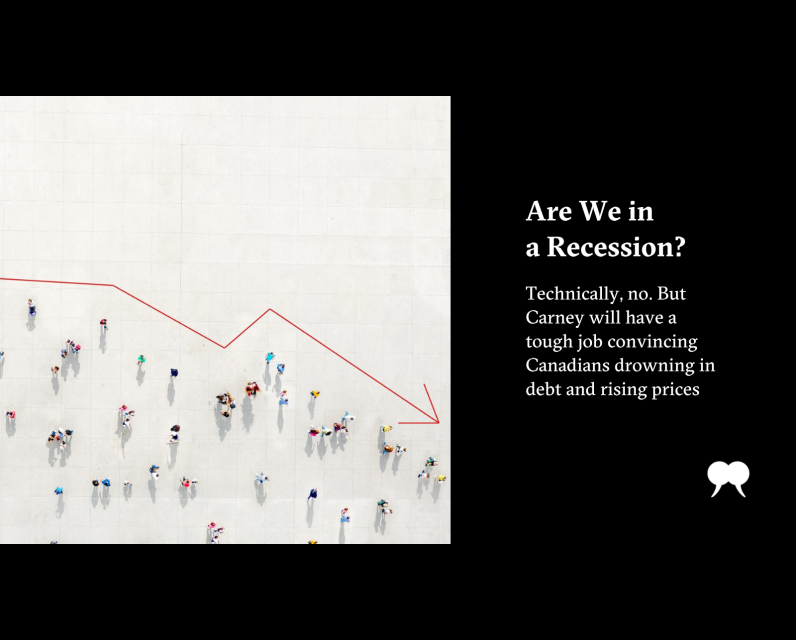Are We in a Recession?

Who’s ready for a recession? Almost no one, of course. Certainly not the millions of Canadians—more than half the country—living paycheque to paycheque. Nor those, likely many of the same people, who’ve collectively sunk $2.5 trillion into consumer debt, $122 billion of which is owed to credit card companies. Canada has weathered recessions before, but the forecast today looks severe, darkened by problems like record-high youth unemployment. If the downturn comes, it may not be a passing squall we can just ride out.
It’s little wonder the Bank of Canada is trying to calm fears. In the spring, as economists surveyed by Bloomberg News warned, Canada was at the outset of a recession; the bank admitted US president Donald Trump’s trade war could be to blame. Last month, of the economic outlook, the bank’s governor, Tiff Macklem, said, “It’s not going to feel good. It is growth, but it’s slow growth.” This, however, is the same institution that downplayed inflation fears back in 2021, just before the consumer price index rate surged. On September 17, the bank cut the prime interest rate to 2.5 percent, noting that while it didn’t expect a recession, the economy is weaker. Perhaps it believes what it says. Perhaps it’s wishful thinking. Perhaps it’s something in between. But the bank isn’t alone. Consultancy firm Deloitte predicts Canada will make it out of 2025 without hitting a technical recession. Hope abounds.
That optimism lasts only until you look at the latest data and parse the meaning of “technical.” Statistics Canada said in August that, in the quarter ending June 30, the economy shrank at an unexpectedly high annualized rate of 1.6 percent. Recessions are typically defined as back-to-back quarters of negative gross domestic product growth, which is taken as rough evidence that economic activity is going into reverse. The last GDP drop, prior to the recent one, came in the third quarter of 2023. As we wait for the next one, what do we do about the gap between the technical threshold of a recession and the hardship households face?
Definitions, in other words, only tell part of the story—one that economists like Trevor Tombe say misses lived reality. In The Hub, Tombe argues that with “widespread job losses and rising unemployment, it already feels like a recession for many Canadians.” Tombe’s emphasis on feeling is important, reflecting at once that whatever textbook or rough-and-ready rules say, what matters is how households encounter the economy day to day, and whether they believe they can make it through. Lately, that experience has been bleak.
Citing research from Abacus Data, Tombe points out that household anxiety is elevated. People are squeezed and nervous. Research by the Bank of Canada found that post-pandemic prices had declined but hadn’t normalized by 2024. Even as the rate of inflation drops, core economic challenges persist: Housing is too expensive, particularly in cities where people are seeking jobs. Years of inflation have eroded confidence, trust, and purchasing power, with poorer Canadians hit the hardest. Mortgage arrears are low, but rising. And now Canada is duking it out with the global hegemon and its top trading partner while struggling to diversify trade, both internally and externally, and promising to build the nation through infrastructure projects.
It’s a dilemma Prime Minister Mark Carney has been circling for months: households are stretched thin, yet the country’s real test lies in how it rewires an economy still overwhelmingly tied to the United States. Trade diversification is hard, long-term work. It’s typically easier to trade across a land border, shipping goods and offering services to a country with whom we share—as much as few wish to admit it right now—cultural, economic, and industrial affinities and ties, including roads and bridges. The costs of a trade war are immediate; the returns of diversification and massive infrastructure project efforts—if they come at all—not so immediate. In the meantime, we struggle. Soon, we will seek someone to blame for that struggle.
As the economy shrank last quarter, Statistics Canada noted that federal spending on goods and services—a catch-all that usually covers everything from construction projects and office supplies to IT contracts and professional services—rose 5.1 percent, keeping the decline from being even more precipitous. There’s nothing new or surprising there—that’s Keynesianism 101. But the Carney government has promised an “austerity” budget in November, though one the Liberals promise will double as an “investment” plan. As the risk of an official recession—or the revelation that we’ve been in one—looms, the details of the government’s magical cut-and-invest budget will matter a great deal.
The risk of inflation remains something to consider, but so, too, does massive unemployment. Fears of stagflation—which you get when prices keep rising even as growth stalls—shouldn’t be overstated, but they are worth taking seriously. Stagflation would mean higher costs and weaker paycheques, fewer jobs and less investment, and more families falling behind on mortgages or maxing out their credit cards just to buy groceries.
Is Canada headed in that direction? It doesn’t appear so right now, but the US faces the prospect of just that. As the old trope goes, when America sneezes, the world catches a cold. And who stands to get sick first? Whoever is closest. Canada, which has a trade relationship worth roughly $1 trillion a year with the US, and to whom we send approximately 75 percent of our exports, fits the bill. Call us patient zero, or one.
In the environment of the day, a recession is both an economic and political risk. Carney never promised that he could control Trump. “We can’t control what President Trump will do next,” he said last March, just days before winning the Liberal leadership contest and becoming prime minister. He was right. He did promise, however, that he was the leader with a plan, with the capacity to best manage Canada’s response to whatever the mercurial president might decide to do, or not do, on any given day. So, while he’s not responsible for Trump, the prime minister is responsible for Canada and our response to external events. That the Carney government is barely six months old is of analytical importance, but the political value of its youth as a tool for deflecting blame may fade fast.
For now, Canadians are giving Carney’s ministry a long leash, recognizing, perhaps, that change takes time and circumstances are far from ideal. With Parliament back in session, Conservative leader Pierre Poilievre returned to the House of Commons, and no deal with the US on the horizon despite promises of one, the anxieties, frustrations, and struggles that Canadians are enduring may soon find someone to blame, and it won’t be Trump forever.
That frustration matters because Carney governs with only a minority. In recent months, it seemed a safe bet that should an election call come in the next eighteen months or two years, it would come from the government itself looking to capitalize on propitious circumstances to secure a proper majority. The odds of that are lengthening day by day—roughly, I’d expect, in proportion to a decline in the state of the economy over time.
For its own good, and, more importantly, the good of Canadian households, the government ought to be focused on short-term support for those who are struggling because of the economic downturn, ensuring that the country doesn’t enter a cycle of layoffs and debt defaults. It should also concern itself with the long-term building out of the welfare state, a project undertaken, at least in part, by the Justin Trudeau government with the Canada Child Benefit and flawed, but nonetheless welcome, dental care and pharmacare programs. Building infrastructure, as Carney has promised, may be fine and good.
But if the government insists on focusing on a massive boost to military spending and tax cuts at the cost of public investments to directly support Canadians, it will have only itself to blame when those who gave the Liberals a lease on life last spring opt for an alternative the next time around—and sooner rather than later.
The post Are We in a Recession? first appeared on The Walrus.


Comments
Be the first to comment